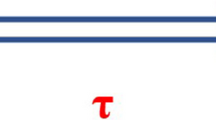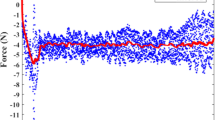Abstract
In the process of aeroengine blade grinding, the vibration of the robot reduces the precision of grinding force control at the end, which seriously affects the processing quality of the blade. Thus, a macro–micro grinding system composed of a robot and a pneumatic end-effector is constructed. The system is controlled by the robot to realize the position and the end-effector to realize the force control. Based on a simplified model of the robot and the end-effector, a force compensation strategy combining a dynamic matrix prediction algorithm and an impedance compensation method is proposed. The axial grinding force and vibration compensation force are rolling optimized in a limited time domain in a way of minimizing the quadratic performance index, the time lag of the force compensation process and the uncertainty of model parameters are compensated, and the grinding force can be tracked stably is realized. The simulation and experimental results indicate that the method can quickly suppress the vibration, decrease the force fluctuation, and improve the blade grinding quality.















Similar content being viewed by others
Data availability
Available on request.
Code availability
The codes that support the findings of this study are available from the corresponding author upon reasonable request.
References
Xiao GJ, Chen BQ, Li CS, Zhuo XQ (2022) Fatigue life analysis of aero-engine blades for abrasive belt grinding considering residual stress. Eng Fail Anal 131:105846. https://doi.org/10.1016/j.engfailanal.2021.105846
Chen ZS, Sheng HS, Xia YM, Wang WM, He J (2021) A comprehensive review on blade tip timing-based health monitoring: status and future. Mech Syst Signal Process 149:107330. https://doi.org/10.1016/j.ymssp.2020.107330
Zhu DH, Xu XH, Jiang C, Li WL (2021) Research progress of robot grinding and polishing technology for complex blades. Acta Aeronaut Astronaut Sin 42:8–30. https://doi.org/10.7527/S1000-6893.2020.242
Zhu DH, Feng XZ, Xu XH, Yang ZY, Li WL, Yan SJ, Ding H (2020) Robotic grinding of complex components: a step towards efficient and intelligent machining-challenges, solutions, and applications. Robot Comput-Integr Manuf 65:101908. https://doi.org/10.1016/j.rcim.2019.101908
Kakinuma Y, Ogawa S, Koto K (2022) Robot polishing control with an active end effector based on macro-micro mechanism and the extended Preston’s law. CIRP Ann Manuf Technol 71:341–344. https://doi.org/10.1016/j.cirp.2022.04.074
Li J, Guan YS, Chen HW, Wang B, Zhang T (2020) A high-bandwidth end-effector with active force control for robotic polishing. IEEE Access 8:122–135. https://doi.org/10.1109/access.2020.3022930
Wei YZ, Xu QS (2022) Design of a new passive end-effector based on constant-force mechanism for robotic polishing. Robot Comput-Integr Manuf 74:102278. https://doi.org/10.1016/j.rcim.2021.102278
Dai SJ, Li SN, Ji WB, Sun ZL, Zhao YF (2021) Force tracking control of grinding end effector based on backstepping+ PID. Ind Rob 49:34–46. https://doi.org/10.1108/IR-10-2020-0229
Zhang GL, Yang GL, Deng YM, Chen CY, Zhu RF, Yang KS (2022) Modeling and force control of a pneumoelectric end-effector for robotic continuous contact operations. Int J Adv Manuf Technol 121:1219–1234. https://doi.org/10.1007/s00170-022-09413-8
Tao B, Zhao XW, Li RP, Ding H (2020) Research and application of robot measurement operation machining integration technology. China Mech Eng 31:49–56. https://doi.org/10.396/j.issn.1004-132X.2020.01.006
Pervez MR, Ahamed MH, Ahmed MA, Takrim SM, Dario P (2022) Autonomous grinding algorithms with future prospect towards SMART manufacturing: a comparative survey. J Manuf Syst 62:164–185. https://doi.org/10.1016/j.jmsy.2021.11.009
Furtado LFF, Villani E, Trabasso LG, Sutério R (2017) A method to improve the use of 6-dof robots as machine tools. Int J Adv Manuf Technol 92:2487–2502. https://doi.org/10.1007/s00170-017-0336-8
Newman M, Lu KY, Khoshdarregi M (2021) Suppression of robot vibrations using input shaping and learning-based structural models. J Intell Mater Syst Struct 32:1001–1012. https://doi.org/10.1177/1045389X20947166
Nguyen V, Cvitanic T, Melkote S (2019) Data-driven modeling of the modal properties of a six-degrees-of-freedom industrial robot and its application to robotic milling. J Manuf Sci Eng 141(12):121006. https://doi.org/10.1115/1.4045175
Nguyen V, Johnson J, Melkote S (2020) Active vibration suppression in robotic milling using optimal control. Int J Adv Manuf Technol 152:103541. https://doi.org/10.1016/j.ijmachtools.2020.103541
Mohammad AEK, Hong J, Wang D (2018) Design of a force-controlled end-effector with low-inertia effect for robotic polishing using macro-mini robot approach. Robot Comput-Integr Manuf 49:54–65. https://doi.org/10.1016/j.rcim.2017.05.011
Ivanov V, Botko F, Dehtiarov I, Kočiško M, Evtuhov A, Pavlenko I, Trojanowska J (2022) Development of flexible fixtures with incomplete locating: connecting rods machining case study. Machines 10(7):493. https://doi.org/10.3390/machines10070493
Bao Y, Wang B, He ZX, Kang RK, Guo J (2022) Recent progress in flexible supporting technology for aerospace thin-walled parts: a review. Chin J Aeronaut 35:10–26. https://doi.org/10.1016/j.cja.2021.01.026
Jiang X, Zhao G, Lu W (2020) Vibration suppression of complex thin-walled workpiece based on magnetorheological fixture. J Manuf Syst 106:1043–1055. https://doi.org/10.1007/s00170-019-04612-2
Wojciechowski S, Maruda RW, Krolczyk GM, Niesłony P (2018) Application of signal to noise ratio and grey relational analysis to minimize forces and vibrations during precise ball end milling. Precis Eng 51:582–596. https://doi.org/10.1016/j.precisioneng.2017.10.014
Wang Q, Wang W, Zheng L, Yun C (2021) Force control-based vibration suppression in robotic grinding of large thin-wall shells. Robot Comput-Integr Manuf 67:102031. https://doi.org/10.1016/j.rcim.2020.102031
Cheng MD, Guo JJ, Li Z, Li GM (2018) Vibration suppression for thin-wall plate machining using eddy-current damping. J Mech Eng 17:76–84. https://doi.org/10.3901/JME.2018.17.076
Yuan X, Wang S, Mao X, Liu H, Liang Z, Guo Q, Yan R (2022) Forced vibration mechanism and suppression method for thin-walled workpiece milling. Int J Mech Sci 230:107553. https://doi.org/10.1016/j.ijmecsci.2022.107553
Chen F, Zhao H, Li D, Chen L, Tan C, Ding H (2019) Contact force control and vibration suppression in robotic polishing with a smart end effector. Robot Comput-Integr Manuf 57:391–403. https://doi.org/10.1016/j.rcim.2018.12.019
Zhou P, Zhao X, Tao B, Ding H (2020) Time-varying isobaric surface reconstruction and path planning for robotic grinding of weak-stiffness workpieces. Robot Comput-Integr Manuf 64:101945. https://doi.org/10.1016/j.rcim.2020.101945
Yang Z, Chen C, Chen W, Chen H, Liu Z (2022) Improved sliding mode dynamic matrix control strategy: application on spindle loading and precision measuring device based on piezoelectric actuator. Mech Syst Signal Process 167:1–19. https://doi.org/10.1016/j.ymssp.2021.108543
Guo X, Li C, Luo Z, Cao D (2021) Modal parameter identification of structures using reconstructed displacements and stochastic subspace identification. Appl Sci 11(23):11432. https://doi.org/10.3390/app112311432
Funding
This work is jointly funded by the National Key Research and Development Program of China (Grant number 2019YFB1311104) and the China Natural Science Foundation (Grant number 52005154).
Author information
Authors and Affiliations
Contributions
All authors contributed to the study conception and design. Shijie Dai: resources and validation; Shuyuan Liu: conceptualization, methodology, and writing—original draft; Wenbin Ji: writing—review and editing; Shida Li: investigation and supervision. All authors read and approved the final manuscript.
Corresponding author
Ethics declarations
Ethics approval
Not applicable.
Consent to participate
All authors agree to participate.
Consent for publication
All authors agree to publish.
Conflict of interest
The authors declare no competing interests.
Additional information
Publisher's note
Springer Nature remains neutral with regard to jurisdictional claims in published maps and institutional affiliations.
Rights and permissions
Springer Nature or its licensor (e.g. a society or other partner) holds exclusive rights to this article under a publishing agreement with the author(s) or other rightsholder(s); author self-archiving of the accepted manuscript version of this article is solely governed by the terms of such publishing agreement and applicable law.
About this article
Cite this article
Dai, S., Liu, S., Ji, W. et al. Vibration suppression in macro–micro grinding system of aeroengine blade based on impedance compensation prediction control strategy. Int J Adv Manuf Technol 125, 793–807 (2023). https://doi.org/10.1007/s00170-022-10721-2
Received:
Accepted:
Published:
Issue Date:
DOI: https://doi.org/10.1007/s00170-022-10721-2




